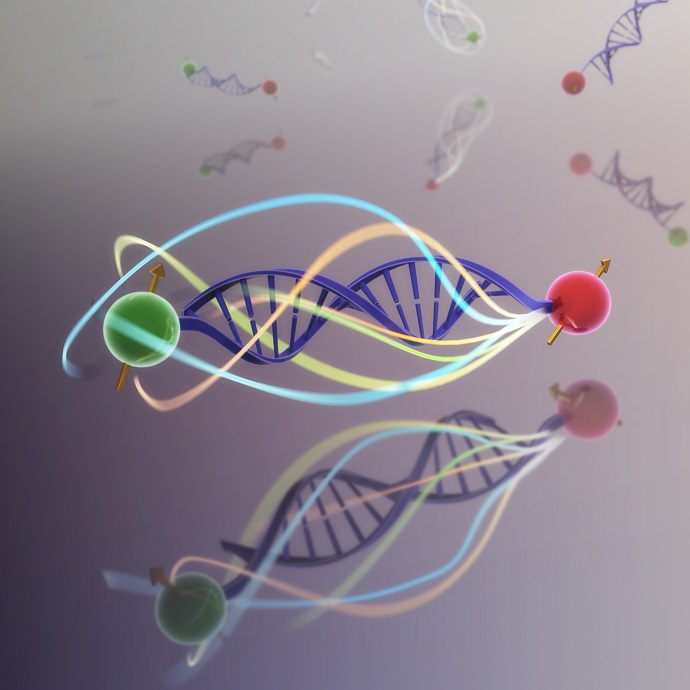31 May 2016
Scientists at the Technical University of Denmark, the University of Twente and the FOM Foundation have settled an old scientific debate on whether or not the energy transfer between two molecules depends on their nano-environment. They found that a flat mirror close to a pair of molecules hardly influences their energy transfer rate, while it greatly affects the light emission by a single molecule. Only mirrors as close as the distance between the molecules influence the energy transfer. Their work is relevant to applications in lighting, nano-sensing, photosynthesis, photovoltaics, and quantum information processing. The results were published yesterday in the leading British-German magazine New Journal of Physics.
It is widely debated whether the rate at which energy is transferred from one excited molecule to a closely spaced second molecule can be influenced by modifying their nanophotonic environment. Spontaneous emission from a single molecule (or any other light source) does depend sensitively on its nanophotonic environment. Controlling the environment is possible with so-called metamaterials, photonic crystals or even with a flat mirror. Previous studies on the energy transfer between two molecules found either strong effects, moderate effects or no effect at all from the nano-environment, resulting in confusion among theorists and experimentalists.
Romantic dinner
First author dr. Martijn Wubs (Technical University of Denmark) uses an analogy to explain the problem: "When you fancy someone, going to a romantic restaurant may help to actually fall in love. The romantic environment might even be the main reason for falling in love, but such matters of the heart are notoriously difficult to interpret and understand. For the analogous situation of energy transfer between two molecules 'in love' we have now managed to understand the influence of their environment."
New model to understand observations
Four years ago, the Danish-Dutch team participated in an experimental study that demonstrated that for a pair of molecules, the energy transfer rate is independent of the so-called local optical density of states of their nanophotonic environment (as opposed to single-molecule emission which does depend on this density of states). This posed a challenge for theorists to understand the observations. They decided to investigate the simplest possible model system possessing all essential features of the experiments. "The model system allowed us to derive exact analytic expressions and thereby draw firm conclusions," says FOM group leader prof. Willem Vos (University of Twente). "We found a theoretical expression that shows the energy transfer rate is exactly independent of the local density of states of the nanophotonic environment. Surprisingly, such a simple expression had not been derived before."
Double check
To verify that they did not 'skip towards the answer', the researchers also derived a theory wherein they insisted the rate to depend on the nanophotonic environment. This theory confirmed their conclusions. Vos explains: "Energy transfer is not mediated by light in its usual sense of an electromagnetic wave with the shape of a sine-wave. The molecules are much closer together than the wavelength of light, hence light emitted by one molecule has not yet become a sine-wave when arriving at the second molecule. Thus, there is no nano-light-effect on the energy transfer rate. However, the molecules do 'feel each other' by the Coulomb force that occurs between molecular charges."
Flat mirror
It might seem that there really is no way to control the energy transfer rate between two molecules, but the Coulomb force offers an escape. Vos: "We found that the energy transfer rate is strongly influenced by placing the pair of molecules in close proximity of the mirror, at nano-distances comparable to the separation between the molecules.* It seems like the molecular lovers fall in love more strongly when they are so close to a mirror that they first see themselves before seeing their partner. Due to the nano-Coulomd-effect, they are not distracted by the rest of the world and can focus better on their partner."
The researchers believe that their new insight in the control of energy transfer can be exploited for accurately measuring molecular separations over long ranges, for the manipulation of quantum information between nearby quantum dots, for improved bio-sensors, and in photovoltaics.
*) By contrast, for spontaneous emission from a single molecule it is known that a mirror has an influence on much larger distances of the order of the wavelength of light.
Team
The research was performed by associate prof. Martijn Wubs, Department of Photonics Engineering, Technical University of Denmark (DTU), Lyngby, in Denmark, and by prof. Willem Vos from the Complex Photonic Systems (COPS) chair, at the MESA+ Institute for Nanotechnology, University of Twente, in the Netherlands. The manuscript was a remote collaboration, as it was edited with a common online internet editor, supplemented with frequent skype discussion.
The research is funded by the Danish Council for Independent Research, the Danish National Research Foundation, the Villum Foundation, and by the Vrije FOM-programme 'Stirring of Light!' that is supported by the Foundation for Fundamental Research on Matter (FOM), the Netherlands Organisation for Scientific Research (NWO), and Technology Foundation STW.
Reference
Martijn Wubs and Willem L. Vos, Förster resonance energy transfer rate in any dielectric nanophotonic medium with weak dispersion, New Journal of Physics 18, 053037 (2016). You can also visit www.complexphotonicsystems.com.













